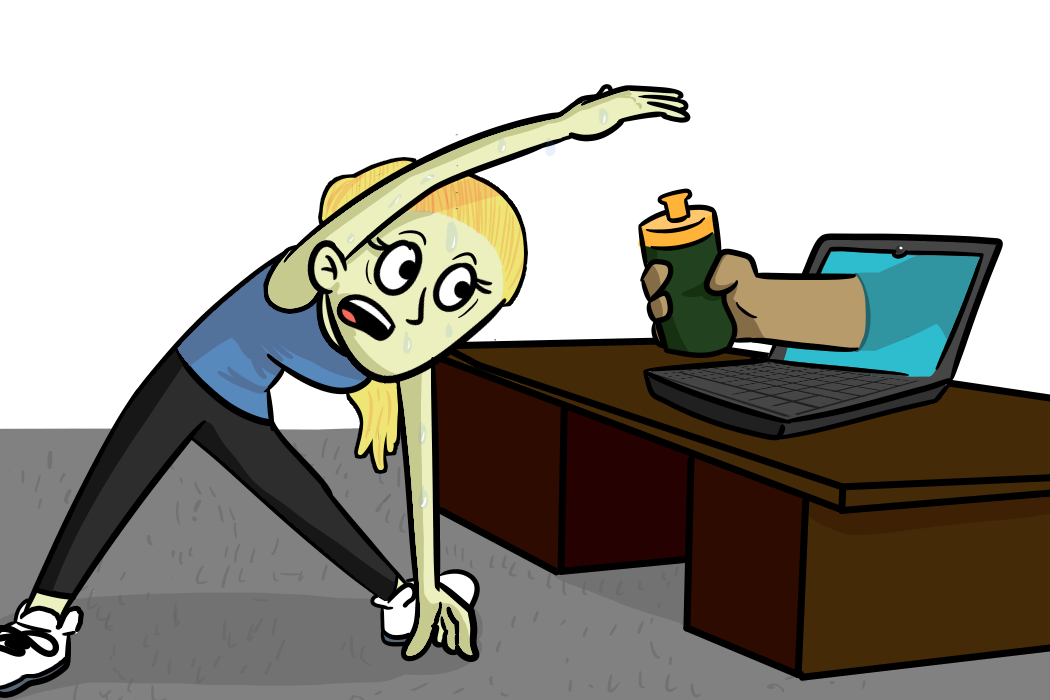Your donation will allow our student journalists to continue their work. You may become a PATRON by making a donation at one of these levels: White/$30, Black/$50, Gold/$100. Patron names will be published in the print newsmagazine, on the website and once per quarter on our social media accounts.
Hands-on classes learn to be hands-off, online
April 6, 2020
With the switch to the Alternative Learning Plan (ALP) within the Rockwood School District, many hands-on classes have found they are no longer able to use the tools provided in the building to teach students. These changes have resulted in many creative ways to work around the obstacles to still provide material for students to learn.
Physical Education classes workout at home with videos, activity logs
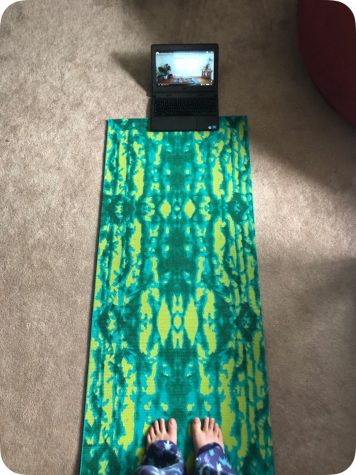
Senior Rachel Paese warms up to start doing yoga for her Total Body Wellness class. “[Online gym class] provides me with online resources, videos, and a variety of ways to work out while stuck at homes, which is really nice,” Paese said.
Physical Education (PE) is now being done through Google and Canvas.
PE teacher Rick Voss is using Google Classroom to keep in touch with his students and give them assignments.
“I have created Google Classrooms for all my PE classes to get information to the students. I created an activity log for the students to keep track of the minutes that they are active and the type of exercise. That will allow for them to do the types of exercise that they have available to them,” Voss said.
Students are expected to exercise and do some activity throughout the week. What the student does is then recorded onto an activity log that is turned in weekly.
“Every student’s situation is different. At the end of the week, each student will complete a Google Form telling me about their activities. We are going to start out keeping it simple and progress from there,” Voss said.
Students are given suggested exercises each week by their teacher that they can choose to follow or not.
“We want our students to engage in activities they enjoy. So although teachers may be posting ideas for workouts, there is flexibility for students to choose from their favorite or preferred activities,” PE Department Chair Denise Meyer said. “Few students will have the same equipment at home that they have access to at school. Therefore, the workouts/exercises suggested by our department are bodyweight exercises that need no equipment. But again, students may utilize any resources that they have access to and be creative.”
Suggested exercises are also geared towards that particular class.
“For example, [there’s] Team Sports. It’s impossible to play a team sport right now, however, it is possible to work on some individual skills and to work on a base level of fitness that will improve performance in any kind of sport. A student enrolled in Team Sports may spend individual time juggling a soccer ball, hitting off a tee, practicing ball-handling skills as part of their 120-150 minutes of exercise,” Meyer said.
Some students are enjoying PE online at their homes since it provides a reminder to get creative with exercise during the day spent at home.
“Obviously I miss the community of my PE class and having some structure and a teacher; however, I like that online PE reminds me to get exercise during this time,” Rachel Paese, a senior in Total Body Wellness, said.
Science labs aim to help students get away from computer
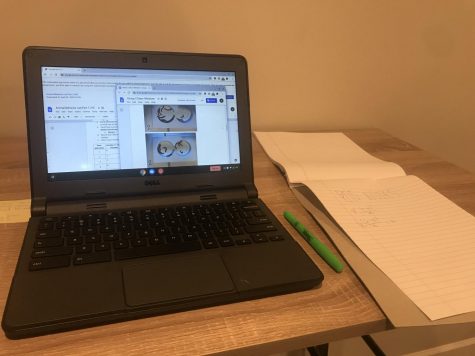
Students in science classes have to do some labs online. Teachers like Scott Holtmann use online resource to allow students to see actual lab results through photos and videos.
Science classes have also had to adjust to the new shift in schooling. A key component of science classes revolves around the ability of students and teachers being able to work through lab activities. Because they are no longer able to complete these together, labs have been changed to adapt to the materials students have available to them.
“One of the major labs for our current unit [in Advanced Placement (AP) Biology] is the animal behavior lab. For this, a teacher in the AP [Biology] District Professional Learning Community had her kids at home do the lab, and she took pictures [that she shared with the community],” Scott Holtmann, AP and Honors Biology teacher, said. “This gives you all a chance to see the observations and perform the statistical analysis. In short, the focus has to shift a little bit from physically performing it while still maintaining focus on the skills such as data analysis, argumentation and statistical tests.”
Holtmann’s goal has been to keep his students connected to biology while also remaining safe under quarantine.
“My overall goal is to keep my students doing so biology and stay connected through email and weekly zoom chats. I definitely keep accessibility in mind when I’m assigning labs. For example, I found a neat lab where students take a vegetable and get it to sprout roots, however, I opted not to pick this because I did not want to encourage any unnecessary trips to the grocery store while we are supposed to be practicing social distancing,” Holtmann said.
In chemistry, the shift has also prevented the majority of regularly scheduled labs from happening.
“We are not doing labs for regular chemistry. We looked at a lot of virtual labs and didn’t find anything that was engaging or would enhance classroom learning,” Shannon Campbell, chemistry and AP Physics 1 teacher, said.
A lab that can still occur in regular chemistry is set in the acids and bases unit, where Campbell has decided to give an option for students to test objects in their house using a homemade acid-base indicator.
“When we get to acids and bases, you can make an acid-base indicator with red cabbage, so I was thinking of doing an interactive class where students tell me what household products they want to know the pH of and then discuss why the results are the way they are. I was going to show them how to make it themselves if they wanted to test things in their own house,” Campbell said.
For physics, the majority of labs can still be done using phones or Google apps.
“Most students have a timer on their phone and they have a measuring tape/ruler at their house so we can do labs that involve motion. That allows us to do a lot of different types of labs that cover a lot of topics in both AP Physics 1 and 2. Also, Google has an app called Science Journal that accesses the sensors in your phone. The app allows you to make graphs of your own motion,” Campbell said.
The labs planned in chemistry and physics all have one goal: to get students up and away from the computers.
“All the lab activities we have planned are to get them up and moving and not in front of a screen,” Campbell said.
Holtmann has also been using labs to get his students out of their homes and into the outdoors.
“In my Honors Biology class, it’s actually opening doors. I’m sending students outside to make observations of plants and document their observations with pictures. The getting outside aspect of this is much more difficult in a normal class setting, so we’re trying our best to turn our lemons into lemonade,” he said.
Several students in science classes, though, are having a difficult time keeping up with the labs due to less face-to-face time with their classmates.
“I think ALP is making the labs less interactive and engaging. I don’t like them this way as much because I don’t get insight from my lab partners as easily and the labs are simplified and partially done by the teacher,” junior Olivia Moran said about her AP Biology class.
Others are enjoying the ability to see firsthand how different sciences impact the world around them firsthand.
“I like having physics labs out of the classroom because it gives me a chance to apply in my daily life. In the classroom we have all this equipment and things that most people don’t have at home, so, being at home, I get to use tools on my phone to investigate the world around me,” Arjun Suresh, a sophomore in AP Physics 1, said.
Music classes study independently, communicate with groups through Zoom
The shift to online has been especially difficult for music classes. Since all face-to-face classwork is now being conducted over Zoom, class practices for all music groups are now nearly impossible.
“Zoom carries too much delay to sing as a group online, so this is not an option,” Christy Shaffer, the choir director, said.
All band classes will be having weekly check-ins.
“All of the groups are doing weekly check-ins on Zoom with us. We are also offering opportunities to work with small groups on Zoom,” Brad Balog, band director, said.
Choir classes will be using materials already given to them to record for assignments on Google Classroom.
“Choir classes will be given PDFs of the music, a recording of their voice part, and a recording of the piano accompaniments for our upcoming concert. We will discuss the musical terminology and aspects of the music and the students will video or record themselves singing and turn that in on Google Classroom,” Shaffer said.
Orchestra will be having Zoom sectionals, where the principal player will play sections of the piece at hand for the group while every other member is on mute, and one-on-one sessions on top of weekly check-ins.
“My main focus is going to be on like helping [students] with one-on-one stuff. [Principal players are] going to start to like running sectional [over Zoom calls]. If we all try to play on Zoom, the delay is so poor that like you wouldn’t be able to hear anything out of it.” Joesph Gutowski, orchestra director, said.
Guitar classes will be using Zoom classes to discuss chords through their songs to help students better understand that particular piece of music.
“Each class has a Zoom check-in where we can talk and ask questions. Once a week we are trying to still do our Rock Block time with Zoom where we use the chord knowledge we have to learn a suggested song. I will be the only one unmuted and taking students through the chord progressions. They will be using the chat option to ask questions. Using screen and audio sharing, I am hoping that they will be able to get an idea of how to continue the song on their own once we are finished,” Traci Bolton, guitar teacher, said.
Bolton’s classes will also be trading videos to help students feel like they are still playing in groups.
“The guitar classes are working by trading lots of videos. I am posting a variety of small exercises that should take only one to two minutes and others that should take a few days of practice. I’m recording backing tracks so students can still feel like they are playing with other people,” she said.
Some students are having a difficult time being able to play without being able to hear the rest of their classes or groups.
“Because we can’t listen to each other play, it’s going to be difficult to put together pieces. Online orchestra can’t help us improve as much as we could in person. I don’t like it at all, we can’t see our friends in class. Along with how we can’t listen to the music that we produce, it takes some of the beauty out of it,” Colin Cundy, a junior in orchestra, said.
Others aren’t worried about the delays because of how their teachers have handled the situation so far.
“I feel like band online is definitely going to be very different. Since we won’t have live classes to work on the material altogether, it will be a lot more independent. I’ll miss getting to play with the group every day, but I know our teachers are looking out for us and are willing to help us at any time we need. So I am not very worried about things at all,” Aashish Allu, a sophomore in band, said.
Due to the break, concert standings are unknown for the music classes. While all the music groups are hopeful that school will be opened soon, enough time has to be left in the year to make sure a concert can run for the groups.
“Unfortunately, there will be no concerts if we do not get back to school. In addition, we have to get back to school with a reasonable amount of time left to make concerts happen. All of the bands (except Jazz Ensemble) were at the beginning of a new concert cycle when we left for spring break. In hopes of still having concerts, all of the bands are working on their new music individually so that we may be able to put the ensemble together when we return,” Balog said.
The Guitar Festival, which was scheduled to happen on April 17, was postponed.
“The Guitar Festival was scheduled to happen on April 17. That has been postponed. I am currently looking for a new date. That is proving difficult due to the already scheduled concerts for the other performing groups and the rescheduling of other big events. However, I’m confident there will be a time that we will be together again and able to play for our friends and families so stay tuned,” Bolton said.
Regardless of how the concerts may potentially turnout, each director plans to maintain a sense of normalcy for their students in this time.
“Our Jazz Ensemble is doing a listening bracket. They are listening to recordings throughout jazz history and voting for their favorites each week in a “March Madness” style bracket. Even if we do not get back to school, we plan to do all of our end-of-the-year senior recognitions and awards. We want to do everything we can to normalize this unique situation—especially for our senior class,” Balog said.
Guitar students receive each day one of Bolton’s favorite songs like Time Makes Two by Robert Cray, her April 2 pick.
“Each day I am sharing one of my favorite songs with thoughts and ideas of what makes the song so great,” she said.
Gutowski hopes to continue to connect to his students through the classroom even though he cannot do it face-to-face.
“I think that, you know, if nothing else I want to make sure that you all feel like you’re still out if you’re still appreciate it, and I still care about you even when we’re in this situation,” he said.
Material Processes students study pieces of home furniture, other household objects
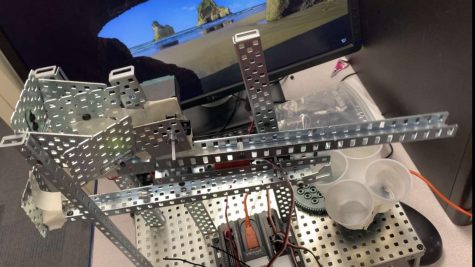
Students in Woods Processes 1 complete their final project done using VEX materials while at school. “[It was a] marble sorter, so it detects marbles made out of different materials and puts them in their proper bins. The tape and cups aren’t VEX [materials] but they were needed in the design it’s supposed to represent recycling and how they sort the materials,” Sara Morgenthaler, senior, said.
Material Processes classes have changed entirely with the district shift to online schooling. Where they once made projects out of metals and woods, students are now having to identify things they learned in class on everyday household items.
“All of my material processes classes are going to be run through Canvas. I have created assignments in a manner that is going to allow students to work with the materials they have on hand at home. Students will not be expected to go out of their way to purchase any materials,” Brennen Dooley, material processes teacher, said.
A part of the assignments students are doing revolves around describing what the object or furniture is used for, what type of metal or wood is it made of, how it is joined together and the quality of the piece.
Not all students enjoy this method. Sara Parikh, a senior in the Woods Processes class, prefers to work hands-on with wood.
“I definitely preferred the hands-on in woods which truly allowed us to learn how to use the equipment and make simple objects. Since most students don’t have access to woodworking tools at home, there obviously was no way we could continue our projects from home. I definitely think this new online method will teach students a different component of woodworking. It’ll help us become more analytical about wooden objects around us,” she said.
Other classes, like Principles of Engineering, are continuing to build at home.
“For Principles of Engineering, we were supposed to be building a catapult that launched a water balloon at our teacher using VEX materials, the parts that move and do things when you hook them up to a computer and write coding, and we’re still going to build one at home but out of recycled materials instead,” Sara Morgenthaler, senior, said.
If students are unable to find materials to build the project, they can write out how they would make the catapult for the assignment.
“Our teachers are being really understanding too about possibly not having materials, so if you reach out to them, they will help you in the best way they can or come up with an alternative,” Morgenthaler said.
Art classes work on different specific skills, mediums
Art classes have changed their basic format to adjust to the new online school format.
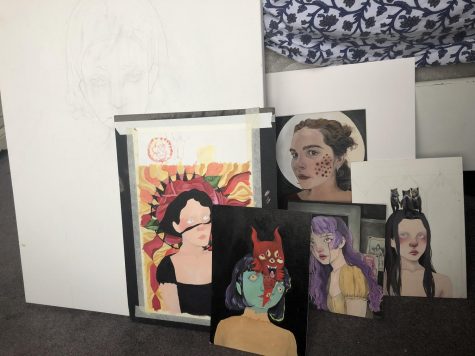
Senior Jane Dunn arranges her artwork at home for her series in AP Art Studio. “So my investigation is sort of fluid, aka it’s not necessarily strict. It’s mainly a collection of characters, all existing in the same universe. I’m working on a piece to connect them all. I think I started wanting to portray more surreal images, deconstructing faces and finding ways to make them unsettling,” Dunn said.
In AP Art and Design, students will continue to work on their portfolios.
“For AP, we are focusing on the exam and digital portfolios of the work we already have. Before school was closed, I was able to photograph the work that was left in the classroom and have shared that with students. After that, we’ll work through a few more projects,” Lauren Sakowski, Art Department Chair, said.
For photography classes, students are to use a digital camera to complete their projects. If they don’t have access to this camera, students are also welcome to use their phones.
“They will be taking photographs with either a DSLR camera if they have one at home or their phones. Actually, some phones have better cameras than some point and shoot cameras. If they do not have access to any sort of camera whatsoever, I do have alternate assignments that they can work on that will still give them the same level of exposure to the content that they need to understand,” Meghan O’Donnell, photography teacher, said.
Students should be able to have access to the photo-editing software through their Chromebooks as well.
“I have revamped projects to make them camera phone user friendly. We also work with Adobe programs, and since Adobe made their products accessible with Chromebooks, we shouldn’t have any problems,” O’Donnell said.
As for Drawing 2 and Painting 2, students can expect to be finishing their remaining sketchbook work for the last few projects for the upcoming four weeks.
Drawing 1 lessons, on the other hand, will focus on specific skills the students have to learn.
“In Drawing 1, we are going to pair it all down to the specific skills the students are needing to learn versus doing full drawing projects. If we get to it at the end of the semester, we will try to create something that draws upon the skill sets they have practiced,” Sakowski said.
Additionally, Painting 1 has many issues with the transition to online schooling.
“Figuring out Painting 1 has posed a real problem though. The four painting teachers from the district have met to figure out just what to do since the majority of students do not have access to materials needed to paint. We’ve had to completely revamp and start with an ‘Alternate/Experimental Media’ assignment where we are encouraging students to find unusual things to ‘paint’ with,” Sakowski said.
Senior Matthias Neumann is enrolled in both Painting 1 and Drawing 2, and he is enjoying the ability to work on his projects in new and comfortable spaces even though he misses the atmosphere of the art classroom.
“I think that the art department is doing a pretty good job compared to everyone else since we’re still given creative freedom to do whatever we want. I do miss having the designated class time to work on the projects, but I do enjoy working on them in a more comfortable environment like my room,” Neumann said.
There are many students who agree with him like senior Jane Dunn.
“Honestly AP Art is like a family to me, so I miss them and Sakowski a lot,” Dunn said. “However, most of [the art students in my class] agree that being stuck at home provides tons more opportunities to make art in our free time and being able to stay up as late as we want helps. Either way, we’re making art, but it’s limited being able to share it and get needed critique.”
Foods cook at home, learn recipes through demo videos
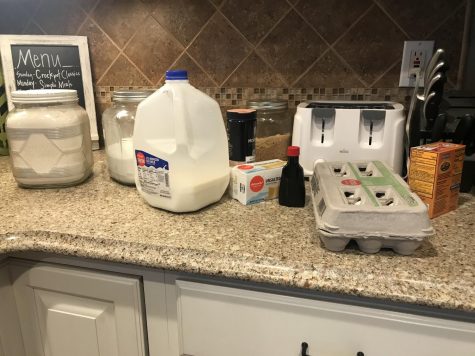
Students in Baking and Pastries class made pound cake during the first week of school at home. Students made the cake while watching demo videos made by their teacher.
Food classes are also hit hard by the shift to online.
Rebecca Lawrence, FACS teacher, has been working with her students to make sure they’re all able to complete the assignments they are assigned.
“I make demo videos pertaining to lab assignments for each week and post [the videos] to Canvas,” she said.
Lawrence encourages her students to conduct small food experiments if they don’t have access to certain foods needed to complete the food assignment.
“I ask my students how many of them can cook without restrictions/parent supervision and whether or not they have access to ingredients. If a student doesn’t have an ingredient or can’t go to the store, they can research a substitute that they do have on hand at home and use that—it would make a great food science experiment too,” Lawrence said.
If students can’t cook due to parental restrictions or other issues, Lawrence gives her students other assignments that depend upon the circumstance and unit that don’t involve cooking that particular food item.
“If a student is not allowed to cook at all at home, then I have alternative assignments for them to complete,” Lawrence said.
Many students are enjoying being able to cook at home, but they are missing having Lawrence and their friends around to cook with them.
“I would say the best part of it would be the comfortability of cooking at my house with my family,” senior Austin Laves said. “The worst part, however, is not cooking with all my friends and not having Chef Lawrence with us to help us.”
